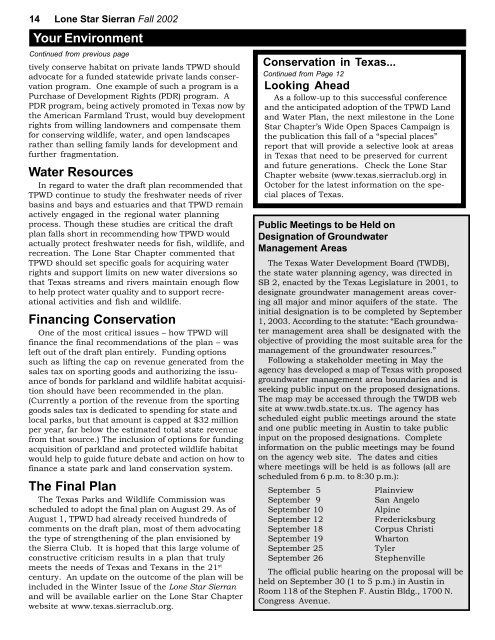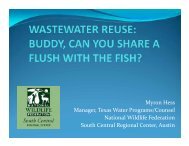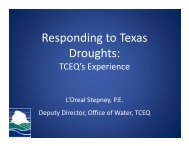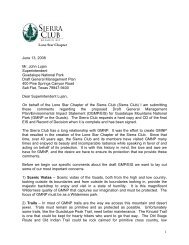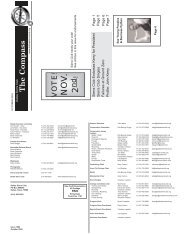Fall 2002 - Lone Star Chapter, Sierra Club
Fall 2002 - Lone Star Chapter, Sierra Club
Fall 2002 - Lone Star Chapter, Sierra Club
Create successful ePaper yourself
Turn your PDF publications into a flip-book with our unique Google optimized e-Paper software.
14 <strong>Lone</strong> <strong>Star</strong> <strong>Sierra</strong>n <strong>Fall</strong> <strong>2002</strong><br />
Your Environment<br />
Continued from previous page<br />
tively conserve habitat on private lands TPWD should<br />
advocate for a funded statewide private lands conservation<br />
program. One example of such a program is a<br />
Purchase of Development Rights (PDR) program. A<br />
PDR program, being actively promoted in Texas now by<br />
the American Farmland Trust, would buy development<br />
rights from willing landowners and compensate them<br />
for conserving wildlife, water, and open landscapes<br />
rather than selling family lands for development and<br />
further fragmentation.<br />
Water Resources<br />
In regard to water the draft plan recommended that<br />
TPWD continue to study the freshwater needs of river<br />
basins and bays and estuaries and that TPWD remain<br />
actively engaged in the regional water planning<br />
process. Though these studies are critical the draft<br />
plan falls short in recommending how TPWD would<br />
actually protect freshwater needs for fish, wildlife, and<br />
recreation. The <strong>Lone</strong> <strong>Star</strong> <strong>Chapter</strong> commented that<br />
TPWD should set specific goals for acquiring water<br />
rights and support limits on new water diversions so<br />
that Texas streams and rivers maintain enough flow<br />
to help protect water quality and to support recreational<br />
activities and fish and wildlife.<br />
Financing Conservation<br />
One of the most critical issues – how TPWD will<br />
finance the final recommendations of the plan – was<br />
left out of the draft plan entirely. Funding options<br />
such as lifting the cap on revenue generated from the<br />
sales tax on sporting goods and authorizing the issuance<br />
of bonds for parkland and wildlife habitat acquisition<br />
should have been recommended in the plan.<br />
(Currently a portion of the revenue from the sporting<br />
goods sales tax is dedicated to spending for state and<br />
local parks, but that amount is capped at $32 million<br />
per year, far below the estimated total state revenue<br />
from that source.) The inclusion of options for funding<br />
acquisition of parkland and protected wildlife habitat<br />
would help to guide future debate and action on how to<br />
finance a state park and land conservation system.<br />
The Final Plan<br />
The Texas Parks and Wildlife Commission was<br />
scheduled to adopt the final plan on August 29. As of<br />
August 1, TPWD had already received hundreds of<br />
comments on the draft plan, most of them advocating<br />
the type of strengthening of the plan envisioned by<br />
the <strong>Sierra</strong> <strong>Club</strong>. It is hoped that this large volume of<br />
constructive criticism results in a plan that truly<br />
meets the needs of Texas and Texans in the 21 st<br />
century. An update on the outcome of the plan will be<br />
included in the Winter Issue of the <strong>Lone</strong> <strong>Star</strong> <strong>Sierra</strong>n<br />
and will be available earlier on the <strong>Lone</strong> <strong>Star</strong> <strong>Chapter</strong><br />
website at www.texas.sierraclub.org.<br />
Conservation in Texas...<br />
Continued from Page 12<br />
Looking Ahead<br />
As a follow-up to this successful conference<br />
and the anticipated adoption of the TPWD Land<br />
and Water Plan, the next milestone in the <strong>Lone</strong><br />
<strong>Star</strong> <strong>Chapter</strong>’s Wide Open Spaces Campaign is<br />
the publication this fall of a “special places”<br />
report that will provide a selective look at areas<br />
in Texas that need to be preserved for current<br />
and future generations. Check the <strong>Lone</strong> <strong>Star</strong><br />
<strong>Chapter</strong> website (www.texas.sierraclub.org) in<br />
October for the latest information on the special<br />
places of Texas.<br />
Public Meetings to be Held on<br />
Designation of Groundwater<br />
Management Areas<br />
The Texas Water Development Board (TWDB),<br />
the state water planning agency, was directed in<br />
SB 2, enacted by the Texas Legislature in 2001, to<br />
designate groundwater management areas covering<br />
all major and minor aquifers of the state. The<br />
initial designation is to be completed by September<br />
1, 2003. According to the statute: “Each groundwater<br />
management area shall be designated with the<br />
objective of providing the most suitable area for the<br />
management of the groundwater resources.”<br />
Following a stakeholder meeting in May the<br />
agency has developed a map of Texas with proposed<br />
groundwater management area boundaries and is<br />
seeking public input on the proposed designations.<br />
The map may be accessed through the TWDB web<br />
site at www.twdb.state.tx.us. The agency has<br />
scheduled eight public meetings around the state<br />
and one public meeting in Austin to take public<br />
input on the proposed designations. Complete<br />
information on the public meetings may be found<br />
on the agency web site. The dates and cities<br />
where meetings will be held is as follows (all are<br />
scheduled from 6 p.m. to 8:30 p.m.):<br />
September 5<br />
Plainview<br />
September 9<br />
San Angelo<br />
September 10<br />
Alpine<br />
September 12<br />
Fredericksburg<br />
September 18<br />
Corpus Christi<br />
September 19<br />
Wharton<br />
September 25<br />
Tyler<br />
September 26<br />
Stephenville<br />
The official public hearing on the proposal will be<br />
held on September 30 (1 to 5 p.m.) in Austin in<br />
Room 118 of the Stephen F. Austin Bldg., 1700 N.<br />
Congress Avenue.


